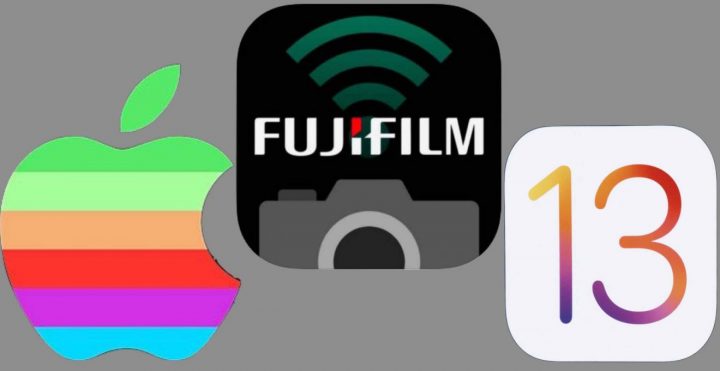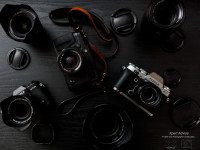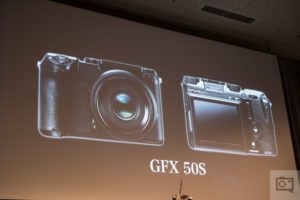
The Fujifilm X-T3 The X-T3 is Fujifilm's newest X-series camera, and potentially represents the largest jump in features and performance that we've seen in a new Fujifilm camera in quite some time.
It boasts a new sensor, faster processor, a significantly improved autofocus system, and video specs that move it close to best-in-class territory.
In short, Fujifilm seems to have taken a no-holds-barred approach to designing this camera, and what the company has delivered is impressive both on paper and in your hands. Let's take a look at some of the headline features worth knowing about.
Body and Controls
The X-T3 is visually similar to its predecessor, the X-T2, though it has a slightly redesigned handgrip. The top plate has the usual Fujifilm dials for ISO, shutter speed, and exposure compensation, and the rear features a tilting touchscreen.
The body includes both a microphone and a headphone jack, along with USB-C and micro HDMI-out ports. The door over these plugs can be completely removed when using the camera with attached cables so that it doesn't get in the way or break, a nice nod to videographers who may want to use the camera rigged with microphones, headphones, or an external recorder.
On the opposite side of the camera are dual-SD card slots that support UHS-II and V60/V90 cards.
New X-Trans Sensor
The X-T3 uses a new 26. 1MP X-Trans backside illuminated CMOS sensor. Although not significantly different in terms of resolution compared to the X-T2's 24MP sensor, this appears to be a sensor we haven't seen in other cameras, so we're looking forward to our testing in order to learn more about its performance.
The new sensor now has a base ISO of 160, compared to 200 on previous Fujifilm models.
Fujifilm tells us that this new sensor has 10x faster readout than its original X-Trans sensor, which is particularly important for some of the camera's new capabilities.
X-Processor 4
In addition to a new sensor, the camera includes a new quad core CPU, called the X-Processor 4. Fujifilm claims it's 20x faster than the original X-Processor in the X-Pro1 and 3x faster then the X-Processor Pro found in the more recent X-H1.
The improved speed is apparent when using the camera as it's quite responsive. Between the new sensor and the new processor, the camera is able to offer significant performance over its predecessors in both photo and video modes.
Autofocus
Fujifilm cameras don't have a reputation for class-leading autofocus performance, but the X-T3 may be the camera that challenges that perception.
It has 425 phase detect autofocus points that provide 99% vertical and horizontal coverage when using single-point AF. Zone and wide tracking modes provide a slightly smaller 91% horizontal x 94. 5% vertical footprint, but that's still pretty impressive. AF points are split into 240 regions, and the system looks at regions both horizontally and independently (for textures). Phase detect AF works down to -3EV (lens not specified), which is two stops better than the X-T2's -1EV.
In our initial use of the camera we've been been very impressed with the new autofocus system
Fujifilm says that improved processing speed, along with an entirely new focusing algorithm, allow the camera to focus 1. 5x faster than the X-T2, enabling accurate autofocus even when photographing subjects that change speed or move erratically across the frame. It also claims to have improved face detection, supports eye-detection in AF-C mode, and says that new face/eye detection algorithms are 2x faster. Face detection is also available when shooting video. However, if there are multiple faces in a scene there doesn't seem to be a way to tell the camera which specific face you want to track.
In our initial use of the camera we've been been very impressed with the new autofocus system, finding it to be fast and very effective at tracking subjects – in some ways very similar to the 3D tracking on Nikon's DSLRs. We'll have to do a lot more testing before we can provide a definitive analysis, but it's fair to say that it's a clear step up from the AF system on previous Fujifilm bodies.
Photos
At 26. 1MP, the X-T3 has only a bit more resolution than its predecessor, though it's not enough that you'll notice a significant difference in image quality from that change alone. However, Fujifilm has made other improvements for still photography that are worth noting.
The camera continues to support all of Fujifilm's excellent film simulation modes, but now includes the company's Color Chrome effect. This was first introduced on the GFX 50S, and is designed to provide improved color gradation in shadow areas that can be difficult to reproduce – on vivid flowers with shadows, for example. There's also a monochrome adjustment option that lets you apply a warm or cool tone to your black and white photos, with nine levels of adjustment in each direction.
The X-T3 continues to use Fujifilm's X-Trans sensor technology, as opposed to the more common Bayer pattern color filter arrays
Now that ISO 160 is part of the standard ISO range (on previous Fujifilm cameras it was available only as an extended setting) it's also possible to capture photos using the DR400% mode for improved dynamic range at ISO 640 instead of ISO 800.
Also new, Raw files now have medium sized (13MP) JPEG previews embedded instead of small JPEG previews, which should make it easier for Raw shooters to review photo details in-camera.
The X-T3 continues to use Fujifilm's X-Trans sensor technology, as opposed to the more common Bayer pattern color filter arrays found on most cameras. Suffice it to say, if you like X-Trans you'll probably still like it on this camera as well. (Or vice versa. )
Video
Video is arguably the area where the X-T3 makes its most significant advances, with features and specifications that have the potential to put it into class-leading territory alongside models like the Panasonic GH5.
To start, the camera supports 4K/60p recording, including both DCI (4096x2160) and UHD (3840x2160) standards. Video can be captured at 4K/60p in 4:2:2 10-bit color via HDMI out, and in 4:2:0 10-bit color when recording internally. You also have the choice of using either H. 264 or the newer H. 265/HEVC codec, with data rates up to 400Mbps, and can choose between All-Intra or Long-GOP recording settings. Shooting video at 400Mbps will require cards that meet the V60 standard.
The X-T3 uses the full width of its sensor to record oversampled 4K video at frame rates up to 30p
Most of these settings can be mixed and matched, creating an impressive array of possible configurations, but there are some restrictions. (For example, 10-bit recording requires use of the H. 265 codec. ) It's possible to record 4K/60p internally at up to 200Mbps while simultaneously recording externally over HDMI.
The camera uses the full width of its sensor to record oversampled 4K video at frame rates up to 30p. There's a slight 1. 18 crop when shooting 4K/60p, which Fujifilm tells us is done in order to maintain the fast scan rate on the sensor.
For slow motion work it can shoot up to 1080/120p, though this comes with a 1. 29x crop of the sensor. This feature was also available on the recent Fujifilm X-H1, but that camera needed to upscale the image a bit in order to do so. In contrast, the X-T3 doesn't have to upscale, but Fujifilm needed to use a slight crop of the sensor to avoid doing so.
According to to Fujifilm there's also a new noise reduction algorithm, including 4K inter-frame noise reduction, and it claims the camera can capture up to 12 stops of dynamic range when shooting video.
Video
In addition to an impressive array of resolutions, data rates, and other options, the X-T3 offers a number of tools and features that should be popular among videographers.
The camera includes Fujifilm's F-Log gamma profile, which can be used either via HDMI or for internal recording, as well as the very pleasing Eterna film profile, which we've found makes a great starting point for color grading if you don't need to use F-Log. Since the X-T3 has a base ISO of 160, the minimum sensitivity for shooting F-Log has also been lowered to ISO 640, compared with ISO 800 on previous Fujifilm cameras.
Movie mode also includes the Silent Control feature found on the X-H1
Fujifilm says the sensor's scan rate is a very quick 17ms, which should provide very good rolling shutter performance and puts the camera into similar territory as the impressive Panasonic GH5 (13ms).
Movie mode also includes the Silent Control feature found on the X-H1, which makes it easy to access video settings using the touchscreen, and also provides a method to retain separate settings for shooting stills and video.
The X-T3 does not include support for Hybrid Log Gamma (HLG) at launch, however Fujifilm says this will come in the form of a firmware update by the end of the year.
Electronic Viewfinder
The X-T3's electronic viewfinder is built around a 3. 69 million-dot OLED with 0. 75x magnification. This is slightly lower than the 0. 77x magnification found on the X-T2, but Fujifilm says they needed to drop the magnification a tiny bit because the new EVF panel is physically larger and requires slightly different optics.
The EVF has a native 60fps refresh rate, but can increase to 100fps in Boost mode without a battery grip attached, unlike the X-T2 which required a battery grip for full Boost mode. It has a 23mm eye-point, the same as the X-H1, and the diopter correction knob must now be pulled out in order to turn it, making it unlikely that it will be inadvertently moved by rubbing against something.
Metering and Focusing
The X-T3 is able to meter and focus at the same time by separating the phase detect AF measurements from the camera's exposure control.
Different lines on the sensor are used to perform autofocus and exposure measurements, reading out at different rates and processing both sets of information in parallel without affecting one another. This gets around the need to switch back and forth between focusing and metering functions, which in certain cases can result in noticeable effects.
For example, when focusing in low light, many mirrorless cameras will briefly show an overexposed image while acquiring focus because they're using the same pixels for AF and exposure measurements and need to increase sensor gain in order to acquire focus. In contrast, the X-T3 has no need to make this temporary adjustment as it's using different pixels for each function.
We were able to see this in action through an informal test of the camera. We set the exposure low enough that the viewfinder was completely black, but the camera was still able to lock focus on a subject in the frame without any change in the viewfinder. This implementation contributes to a very pleasing user experience.
Sports Finder Mode
The X-T3 also has a Sports Finder mode, which can be useful when shooting things for which performance is a priority, such as sports or wildlife. A 1. 25x crop effectively turns the X-T3 into a 16MP camera and the EVF provides clear frame lines to see the cropped area. You can still see outside the cropped area, however, and this can be very helpful as you're able to see things that are slightly out of frame and anticipate their entry into the scene.
Sports Finder mode can be very useful for burst shooting and supports 10, 20, and 30fps burst modes, recording up to 33 Raw images or 60 JPEG images at 30fps, with an EVF blackout of 90ms. A pre-burst mode can also start shooting images as soon as the shutter button is half-pressed.
Performance
Fujifilm claims the X-T3 has the 'highest performance in the history of the X-series'. In continuous shooting mode it can capture 11fps with continuous AF using the mechanical shutter, up to 36 frames, or 20fps using the electronic shutter, up to 34 frames. Neither requires the use of an additional battery grip.
Unlike the X-T2, it's not necessary to have a battery grip attached to fully utilize Boost mode, which increases autofocus speed and increases the EVF frame rate to 100fps.
The X-T3 uses the same NP-W126S battery as other recent Fujifilm models and has a CIPA rating of 390 images, though as with most cameras we expect to get more in practice.
Battery Grip
A new battery grip, the VG-XT3, can be paired with the camera for those who want additional controls for vertical shooting or need additional battery power. It holds two additional batteries to increase the maximum number of shots to 1,100.
The vertical grip includes a shutter release button, focus lever, AE-L button, AF-L button, front and rear command dials, Q button and Fn button so that you have all standard controls available when shooting vertically. It's dust and weather resistant and is rated to operate in temperatures as low as -10C/14F.
Additionally, there's also a new metal hand grip which is designed to make the camera more comfortable to hold when using larger lenses. It's designed so that you can replace both the battery and SD cards without removing it, and the base can be used as a quick release shoe when using a dovetail mount on a tripod.
Night Vision Mode
A new Night Vision mode shifts the display from its standard appearance to a predominantly red mode that's easier on your eyes in low light conditions. It's a bit of a specialized feature, but one that will likely be appreciated by those who shoot frequently in low light.
Pricing and Availability
The Fujifilm X-T3 is launched with an MSRP of $1499 body only, or $1899 with the included Fujifilm 18-55mm F2. 8-4 R LM OIS kit lens, and will ship on September 20.
We've already started testing the camera and look forward to bringing you our full in-depth review soon. Until then, we encourage you to read our Fujifilm X-T3 First Impressions Review to see what we think so far.
. dpreview.com2018-9-6 14:00











